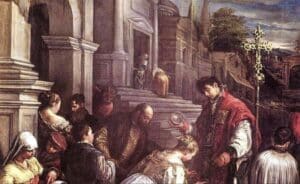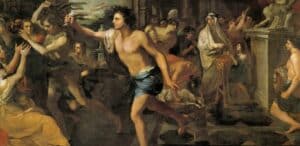The current traditions of Valentine’s Day are rather quite simple. It’s meant to be a special day where couples show their affection for one another with gifts, cards, flowers, and chocolates. The February 14th holiday is popular in the United States, Mexico, Canada, Australia, France, and the United Kingdom. The holiday pulls in approximately $17.6 billion, and $145 million in greeting cards alone. However, this is a far-off depiction of its’ origins, dating back to the Roman Empire.

The mid-February Roman festival, known as Lupercalia, was a celebration of the upcoming spring harvest but also a fertility celebration. During this time, women would be auctioned off to men via a lottery. The celebrations were dedicated to the Roman god of agriculture, Faunus. The entire festival was kicked off by the Roman priests, known as Lupercal, in a scared cave where they would sacrifice a goat and a dog. The goat was a symbol of fertility while the dog was seen as a purification rite. The goat’s pelt was cut into strips and dipped into the dogs’ blood and was taken back into town where the women would flock to the streets and be slapped with the bloody hides. These women welcomed the touch of the bloody animal skin, for they saw it as a sign of being more fertile. The lottery would occur later in the evening where all of the younger, single women would enter their names into a large festival container, typically a decorated urn or jug, and the more well off bachelors would choose a woman’s name randomly to be paired with the following year. More often than not, these pairings would ultimately lead to marriage and conception, perpetuating the cycle.

As time went on and Christianity began to spread across the globe, the Christian church began its’ own feast in the middle of February in hopes of removing the former Lupercalia celebration. The namesake of the new Christian holiday, St. Valentine’s Day, has two well-known variations of its’ origin.
The first, and possibly most well recognized story, tells of the priest named Valentine who served the church during the 3rd century. As Roman Emperor Claudius II decreed that single men acted as better soldiers than husbands and fathers, therefore he outlawed marriage. In an act of defiance, Valentine continued to perform marriages in secret. Once the emperor learned of Valentine’s undermining, he was put to death, only to be seen as a martyr for future generations.

The second story is of an inmate, named Valentine, who helped Christians escape the prisons of Romans. They were being beaten and tortured in an attempt to get them to denounce their god and Valentine could take no more. He secretly broke these prisoners out, only to be eventually be caught himself. Before he was put to death, Valentine was rumored to send the first Valentine card. He sent a love letter to the jailer’s daughter, who often visited him during his time behind bars, and signed it, “From your Valentine.” The letter made it to the young girl only after his execution, and the man’s actions and love letter created an uproar which lead to his martyrdom.
Regardless of the story, both histories have been altered and obscured, the church claimed the day in Valentine’s name after his death around 270 A.D. By the year 400 A.D., Pope Gelasius outlawed the remaining Lupercalia celebrations and officially named February 14th as St. Valentine’s Day. The holiday was not exactly celebrated the way it is today and wasn’t even seen as a festival of love until the late Middle Ages.

In France and England during the Middle Ages, especially recognized by peasants, February 14th was the start of the mating season for birds. This ultimately helped translate the holiday into a romantic day. In 1375, while writing a poem named “Parliament of Foules,” the famous English poet Geoffrey Chaucer recorded St. Valentine’s as a day of romantic celebrations by penning “For this was sent on Seynt (Saint) Valentyne’s (Valentine’s) Day whan (when) every foul cometh ther (there) to choose his mate.” By 1415, the first official Valentine’s Day poem was written by the Duke of Orleans, Charles, to his wife as he was imprisoned in London after he was captured in the Battle of Agincourt. This exact card is still a part of the collection of manuscripts in the British Library. Years following, King Henry V hired John Lydgate, a writer, to compose a St. Valentine’s Day card to Catherine of Valois.
Hearing of these popular figures through time, formal Valentine’s Day cards began publicly traded around the early 1500’s. By the 1700’s, a commercial industry of St. Valentine’s Day cards was created. The United States began printing Valentines cards by the mid-1800’s which really jettisoned the industry into a steadfast and commonplace business. Hallmark Cards was created in 1913 as a mass producer of factory cards out of Kansas City, Missouri. From here, Americans added the cartoon version of Cupid, the historically inaccurate Roman god of love, shooting arrows in the form of hearts.

Whatever the reason for celebrating the holiday of Valentine’s Day, from Roman mythology to current traditions of gift giving, as long as it brings people happiness and love, then the purpose of the holiday is fulfilled as it was originally meant to, even dating back to its’ origins.

What did you think?
Drop a comment below.

